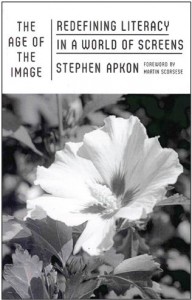Literacy Gone Visual

As a child, I remember being so inconsolable watching the wicked queen poison Snow White, that I actually ran out of the movie theater. Steve Apkon would no doubt say: “It was the power of the image.” Apkon, Founder of the Jacob Burns Film Center, explores visual literacy in his book, The Age of the Image: Redefining Literacy in a World of Screens. In Apkon’s view, mere words, sounds or signals are less pungent as compared to images that have a more direct, immediate, intimate and fluid path to the brain. There, images can be received, processed, appropriated, reformulated and expressed. It’s all in the mirror neurons. Populated as we are with images, or as Apkon calls them – visual stories – in our total environment, we listen, absorb, download, replay and express ourselves differently than we did in a pre-technological era. With new tools of communication available to everyone, we all have the access to record, edit and distribute our own visual stories. Apkon’s book is a call to “embrace technology and use it as a doorway to greater enrichment.” As a regular user of electronic devices, I tend to agree.
Today, everyone is a producer/director and the world is a stage. What we see on the screen is real in Tahrir Square, Aleppo, Damascus, and Gaza. True, it is easier for everyone to be part of the conversation. But, can we process millions of unmediated images without blurring those we wish to retain? With a camera in every hand, will we become numb and number? Or will we learn to be more discerning? Will our visual literacy change the way we celebrate Holy Week? Will we retell the story of Passover online or at virtual seders? And, if we could turn back the hands of time, would YouTube videos have changed the outcome of the Easter story? I’m just thinking.


Connect with Janet